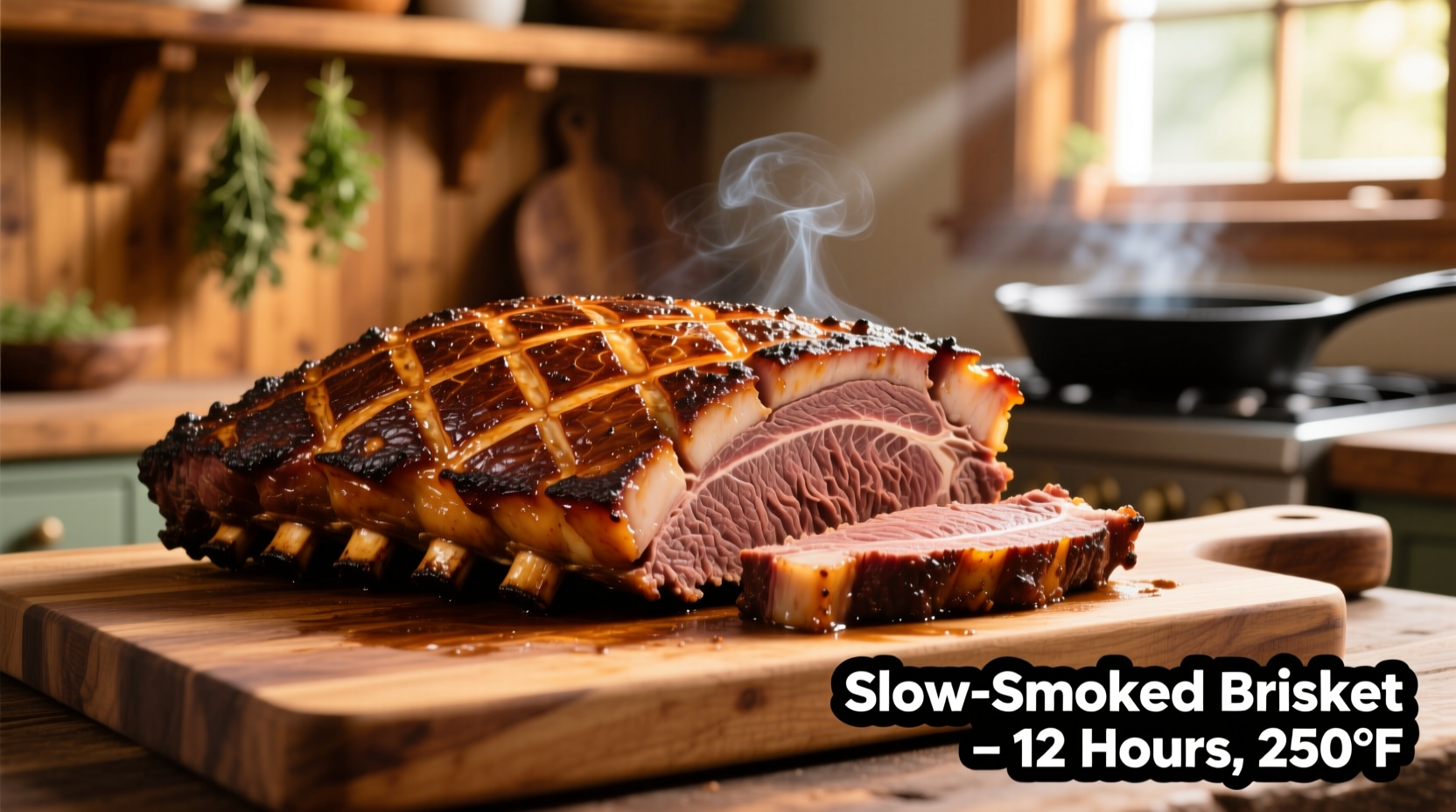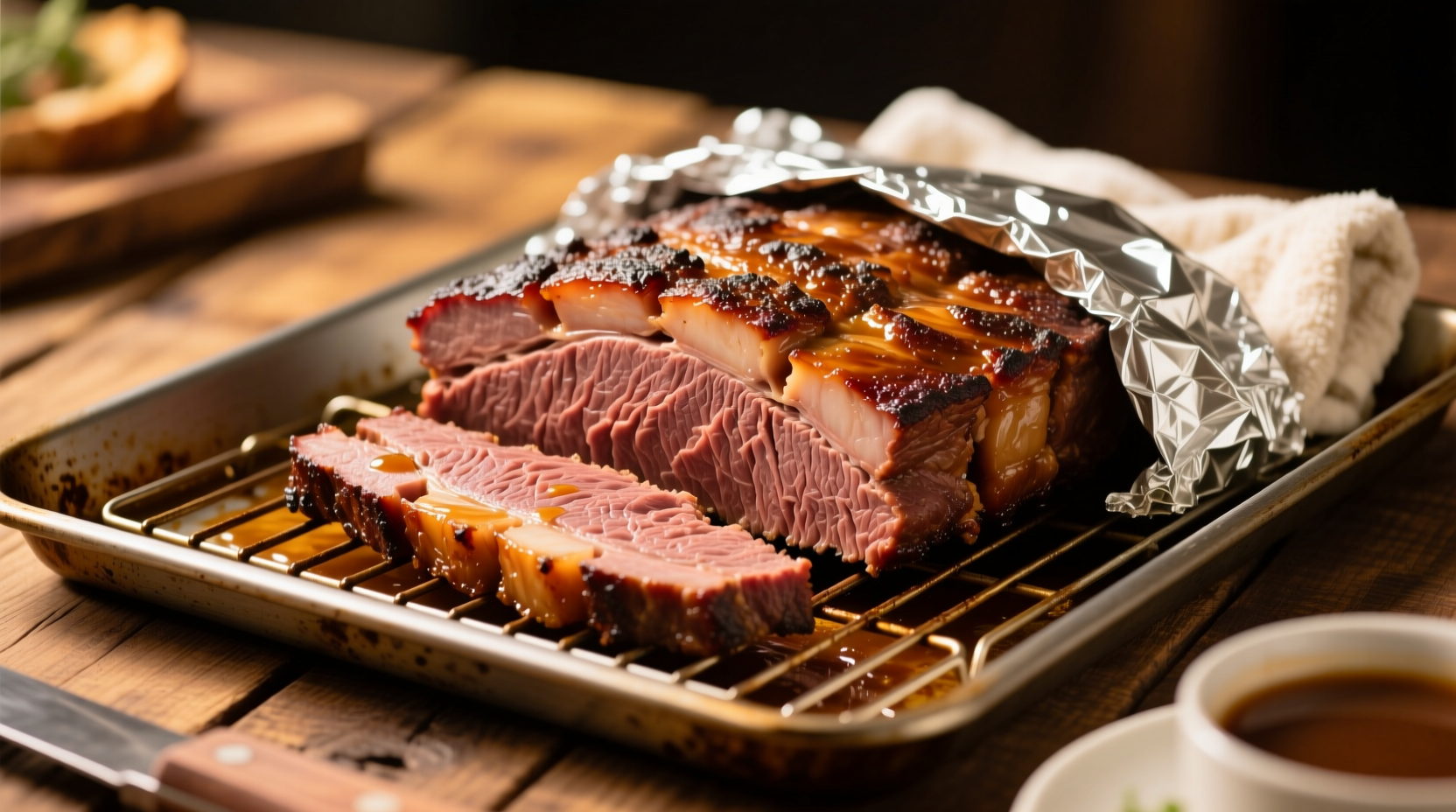Discover the perfect balance of time and temperature for oven-braised brisket that melts in your mouth. This guide delivers science-backed timing, professional chef techniques, and troubleshooting solutions used by pitmasters worldwide - no guesswork required.
The Science Behind Brisket Cooking at 350°F
Cooking brisket isn't just about time - it's a precise chemical process where collagen transforms into gelatin. At 350°F, this conversion happens faster than low-and-slow methods but requires careful monitoring. The USDA Food Safety and Inspection Service confirms that beef brisket must reach a minimum internal temperature of 145°F for safety, but for tender results, you'll need to push further to 195-205°F where connective tissues fully break down (USDA FSIS).
| Cooking Method | Temperature | Time Per Pound | Texture Result |
|---|---|---|---|
| Oven Roasting | 350°F | 30-60 minutes | Firm but tender |
| Low-and-Slow | 225°F | 90-120 minutes | Melts-in-mouth |
| Reverse Sear | 275°F + finish | 60-75 minutes | Crisp exterior |
Your Step-by-Step Brisket Cooking Journey
Preparation Phase: Setting Up for Success
Begin with a properly trimmed brisket featuring 1/4-inch fat cap. Season generously with coarse salt and freshly ground black pepper - this simple rub lets the beef flavor shine. For optimal results, apply seasoning 12-24 hours before cooking to allow penetration. Always bring meat to room temperature (about 65°F) before placing in the oven, which prevents uneven cooking.
Cooking Phase: Timing Your Brisket to Perfection
Place brisket fat-side up in a roasting pan with a wire rack. Insert a digital probe thermometer into the thickest part, avoiding fat pockets. At 350°F:
- First stage (145-165°F): Expect rapid temperature rise - about 30 minutes per pound
- Stall phase (165-190°F): Temperature plateaus as collagen breaks down - this takes 2-3 hours
- Final stage (190-205°F): Temperature climbs again as meat becomes tender
For a 10-pound brisket, total cooking time typically ranges from 5-7 hours. The "poke test" provides a reliable indicator - when a thermometer probe slides in with almost no resistance, your brisket is ready.

Resting Phase: The Critical Final Step
Never skip resting! Wrap brisket tightly in butcher paper or aluminum foil and place in an empty cooler for 1-2 hours. This allows juices to redistribute throughout the meat. Cutting too soon releases precious moisture, resulting in dry brisket. During this phase, carryover cooking will raise internal temperature by 5-10°F.
Context Boundaries: When This Method Works Best
Cooking brisket at 350°F delivers excellent results for specific situations:
- Ideal for smaller cuts under 12 pounds where low-and-slow isn't practical
- Perfect when time constraints exist but you still want tender results
- Works best with well-marbled brisket (USDA Choice or Prime grade)
This method isn't recommended for competition-style brisket or when seeking extreme bark development. For larger cuts over 14 pounds, consider lowering the temperature to 325°F to prevent exterior overcooking.
Pro Tips from Professional Kitchens
Master these techniques to elevate your brisket game:
- The Texas Crutch: When internal temperature hits 165°F, wrap brisket in foil with 1/4 cup beef broth. This speeds through the stall phase while adding moisture.
- Temperature Monitoring: Use a dual-probe thermometer to track both ambient oven temperature and meat internal temperature simultaneously.
- Smoke Infusion: Add wood chips to a smoker box for 2 hours during cooking to incorporate authentic barbecue flavor without specialized equipment.
Troubleshooting Common Brisket Problems
Encountering issues? These solutions come from decades of professional kitchen experience:
- Dry Brisket: Usually caused by overcooking or insufficient resting. Next time, remove at 195°F instead of 205°F and rest for full 2 hours.
- Tough Texture: Indicates insufficient collagen breakdown. Extend cooking time until probe slides in easily, even if past estimated time.
- Burnt Exterior: Lower oven temperature by 25°F next time and position brisket in the center of the oven, away from heating elements.
Evolution of Brisket Cooking Techniques
Brisket preparation has evolved significantly over the past century. In the 1930s, Jewish immigrants in Texas began slow-cooking brisket in cast-iron pots, typically for 8-10 hours. The 1970s saw the rise of commercial smokers, introducing controlled wood-fired cooking. Modern techniques, documented by institutions like the Culinary Institute of America, now emphasize precise temperature control and understanding the science behind meat transformation (CIA). Today's home cooks benefit from affordable digital thermometers and accessible knowledge that previously only professional kitchens possessed.
Frequently Asked Questions
How long to cook a 10 pound brisket at 350 degrees?
A 10-pound brisket requires 5-6 hours at 350°F to reach the ideal 195-205°F internal temperature. Check temperature after 4.5 hours and continue cooking until probe slides in with minimal resistance.
Should I wrap brisket when cooking at 350 degrees?
Yes, wrapping brisket in foil or butcher paper when it reaches 165°F (the stall phase) speeds cooking and retains moisture. Include 1/4 cup beef broth in the wrap for enhanced tenderness.
Why is my brisket tough at 350 degrees?
Brisket remains tough if removed before reaching 195°F internal temperature. Collagen needs this threshold to fully convert to gelatin. Continue cooking until a thermometer probe slides in with almost no resistance, regardless of estimated time.
Can you overcook brisket at 350 degrees?
Yes, cooking beyond 205°F internal temperature causes brisket to dry out. The sweet spot is 195-205°F - check temperature frequently during the final hour to prevent overcooking.
How long should brisket rest after oven cooking?
Rest brisket for 1-2 hours wrapped in foil or butcher paper. This crucial step allows juices to redistribute throughout the meat. Cutting too soon releases moisture, resulting in dry slices.











 浙公网安备
33010002000092号
浙公网安备
33010002000092号 浙B2-20120091-4
浙B2-20120091-4